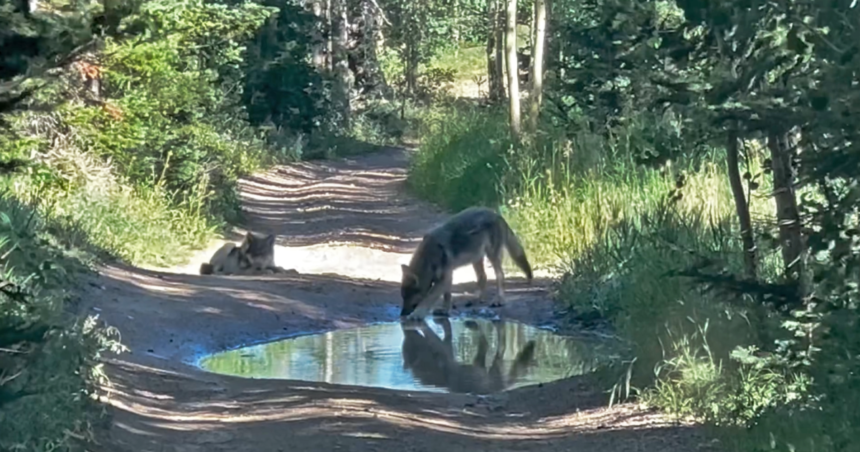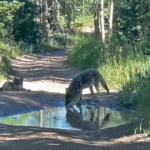Colorado Parks and Wildlife has initiated an operation to capture and relocate the wolves from the Copper Creek Pack. This pack has been responsible for multiple instances of preying on livestock since wolves were reintroduced in the state in December.
CPW announced on Tuesday evening that this process was already in progress, with technical assistance from federal partners. Director Jeff Davis stated that the decision was made after careful consideration and input from various stakeholders.
”Our options in this unique case were very limited, and this action does not set a precedent for how CPW will handle wolf-livestock conflicts in the future,” Davis explained. “The primary goal of the operation is to relocate the pack to a different location while we evaluate the best options for them to continue contributing to the successful restoration of wolves in Colorado.”
RELATED STORY | Colorado hunts for co-existence between people and wolves
The Copper Creek Pack, named in June, consists of at least one breeding pair and three pups. A wolf pack is established when a pair reproduces, which was confirmed on June 18 when CPW biologists observed a single wolf pup at a den site in Grand County. The Copper Creek Pack is the first confirmed wolf pack in Colorado since the reintroduction in December.
The wolf pups were recently captured on video — the first public sharing of such footage — and state officials noted that all the young animals appeared to be in good health.
WATCH: 3 healthy wolf pups spotted in Colorado
The exact details regarding when and how CPW intends to capture the wolf pack and where they plan to relocate them are not currently clear. In response to follow-up questions from Scripps News Denver, CPW mentioned that more information would be released at a later time.
A provision of the federal Endangered Species Act for this wolf reintroduction permits Colorado officials to relocate the wolves. This adoption provided the state wildlife organization with management flexibility for the animals, including tools like aversive conditioning and lethal measures to protect people and livestock, especially post-reintroduction.
“Management of the nonessential experimental population would allow gray wolves in the NEP (nonessential experimental population) to be hazed, killed, or relocated by the Service or our designated agent(s) for livestock depredations,” the document states.
RELATED STORY | Yellowstone National Park’s oldest wolf gave birth to 3 pups this spring
To safeguard the animals, CPW is not disclosing specific details about the location of the Copper Creek Pack. However, during the CPW Commission meeting last week, CPW Assistant Director Reid DeWalt noted that the primary issue with depredation remains with the breeding pair in Middle Park.
“We are actively exploring solutions and opportunities for improvement in that situation,” he stated. “While we have had instances of depredations by a few other wolves, they have not reached the level seen in Middle Park.”
To enhance understanding of wolf depredations, CPW has hired five predator damage conflict specialists who will focus on wolves, as well as black bears and mountain lions.
Throughout the planning and execution of the wolf reintroduction project, CPW has collaborated with wildlife biologists, federal partners, and livestock producers — a collaboration that will continue throughout the process.
As of Tuesday evening, 24 animals — sheep, calves, and cows — had been injured or killed by wolves since the December 2023 release. These incidents occurred in Jackson County, Grand County, and Routt County, with the most recent involving eight sheep in Grand County on July 28.
RELATED STORY | US House votes to remove wolves from endangered list in 48 states
Currently, Colorado is home to 11 known adult wolves — nine introduced in December (originally 10, but one was killed by a mountain lion in April) and two that had previously migrated to Colorado — along with three pups.
The wolf reintroduction was mandated by voters in 2020. In May 2023, the Colorado Wolf Restoration and Management Plan was finalized after years of consultations with community members. By the end of the year, 10 wolves had been released in Grand and Summit counties.
They have since spread to various watersheds in the state, as depicted in the most recent gray wolf activity map below. The map is updated on the fourth Wednesday of every month here. The wolves have not ventured south of Interstate 70 as of the publication date of the map below.
Colorado Parks and Wildlife
The next wolf reintroduction is scheduled to commence this winter in the northern zone, as outlined in the Colorado Wolf Restoration and Management Plan.
It is the upper oval in the map below.

Colorado Parks and Wildlife
In July, a rancher in the Middle Park area, who had experienced multiple confirmed wolf depredations, applied to CPW for permission to lethally remove a wolf due to chronic depredation. CPW had noted wolf-related injuries or deaths to livestock on various dates.
The rancher’s request for a lethal take permit was declined by CPW, as outlined in a letter obtained by Defenders of Wildlife and shared with Scripps News Denver.
In the conclusion of the letter, CPW expressed appreciation for the rancher’s cooperation.
CPW encourages the public to report any wolf sightings, particularly with visual evidence. To submit a report, visit CPW.info/wolf-sighting.
Read the full wolf restoration and management plan below or here.
This piece was initially published by Stephanie Butzer at Scripps News Denver.





